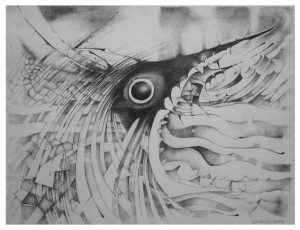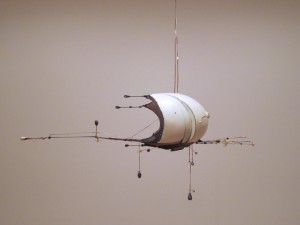Lee Bontecou’s Nostromo
— so foul a sky clears not without a storm (Shakespeare)
Preparations: Take a walk in the common space of Olmsted’s horticultural park, central to Manhattan island geography. Linger for a moment at Willowdell Arch to appreciate the stone voussoirs that line the arcade and support the rusticated underpass; and then allow a few additional moments to visit with Siberian husky Balto – the Alaskan sled dog who braved rough ice and Arctic blizzards to transport serum to the citizens of Nome, stricken by a diphtheria epidemic in terrestrial year 1925. He stands guard, memorialized in a bronze statue just beyond the arch. When your mindspeech has been silenced through remembrance and contemplation, and your senses refreshed by the fading autumn color and the nobility of these sights, follow an easterly course to 73rd street, and ring for admission at No. 25. Take the lift to the third floor, where the doors open onto the stillness of a retreat.
Engineered with a subtle force, Lee Bontecou’s fabrications are “a colossal embodiment of silence,” simul-taneously full of active life. Drawings, models, sand boxes, sand-pits, suspensions, biscuit sculpture, wooden jetties, bear witness to the organization of form ex nihilo; antiquity withdraws in sombre tatters – “the sun eating it up.” Coasting ports and portals; enormous semi-circular temples open to the sky and the ocean. Lofted gondolas float, invisibly anchored, like clippers that are powered by porcelain sails.
Broad curves define the skeletal matrix of blackened canvas and white porcelain that spur the sculptural suspensions. Wire tentacles advance into the plenum like chaff before a hurricane. They float still; where “never a strong wind had been known to blow,” but are haunted by the remembrance of currents that might have once glanced the surface of absent oceans, “like sinister pirate ships of the air, hove-to above the horizon.” (Has earth been depleted of water? Has it lost its aquarian nativity?)
Habitations or conveyances? Shadowed on one side, with patches of sooty fabric on an under side, skirting the horizon, and marking outermost points on the bends of forms that have no titles.
 In drawings that are black and then white and then pottered with images the color of clay, vague forms weave lightly through the glare of a horizon or encircle the oculus of the mind’s eye, the bird’s eye, the reptilian eye, empty of all but a perfectly impenetrable black.
In drawings that are black and then white and then pottered with images the color of clay, vague forms weave lightly through the glare of a horizon or encircle the oculus of the mind’s eye, the bird’s eye, the reptilian eye, empty of all but a perfectly impenetrable black.
Bontecou’s worldscape is utterly waterless; the sand has not soil or nutrient enough to support a single blade of grass, “as if it were blighted by a curse.” I read Conrad’s Nostromo and am reminded of his observation that, “the poor, associating by an obscure instinct of consolation the ideas of evil and wealth, will tell you that the ground is deadly because of its forbidden treasures.”
Grey and black vapors trail out slowly and vanish into thin air along a waiting edge, which reaches for, but seldom wins, the middle ground. It cannot be held; it is eaten up and escapes one’s grasp in the offing.
“In its vastness your ship floats unseen under your feet, her sails flutter invisible above your head. The eye can not find out what work a man’s hand is doing in there; (or a woman’s) and you would be free to call the devil to your aid with impunity if even his malice were not defeated by such a blind darkness.”
Precipices cleave the hardened features of Bontecou’s constructions – glazed by heat; one form resembles an upright spiral of smoke (the remains of a camp-fire?), and is seen riding the sky like a schooner. I gazed into these compilations until my eyesight dimmed, going dark in synchrony, my eye changing with the cinema of the forms. I was exhilarated by the force of character they revealed.
A multitude of small models are collected in the sand-pits; they are spectral and alive. They could have once been dwelling places, or their component parts; rich, and hungry, and thirsty – with “tenacious ghosts suffering in their starved and parched flesh…”
Through the gaps between lines, forms, outcroppings, thoughts of a harbor tempt fantasy; as a refuge from the void. Instead, Bontecou releases us into a plain, curving away in shining parallel ribbons “on a belt of scorched and withered grass.”
Seive-like containers of granular fill, the sand-pits are no more than a half foot high, and about six paces across; an open view passes into opal mystery rough with spines, ceramic scrub, trees in petrified stands huddled close together; spiral clefts spring from shallow depressions; great distances are conjured, overhung by dry haze: the hulls of Bontecou’s extra-terrestrial vision “disregarding everything but the tyranny of time.”
Halo Jones, start December, end year 4952.
All quotes are from Joseph Conrad, Nostromo, The Silver of the Mine, and various subsequent chapters.
Images courtesy and copyright Lee Bontecou and FreedmanArt, New York






